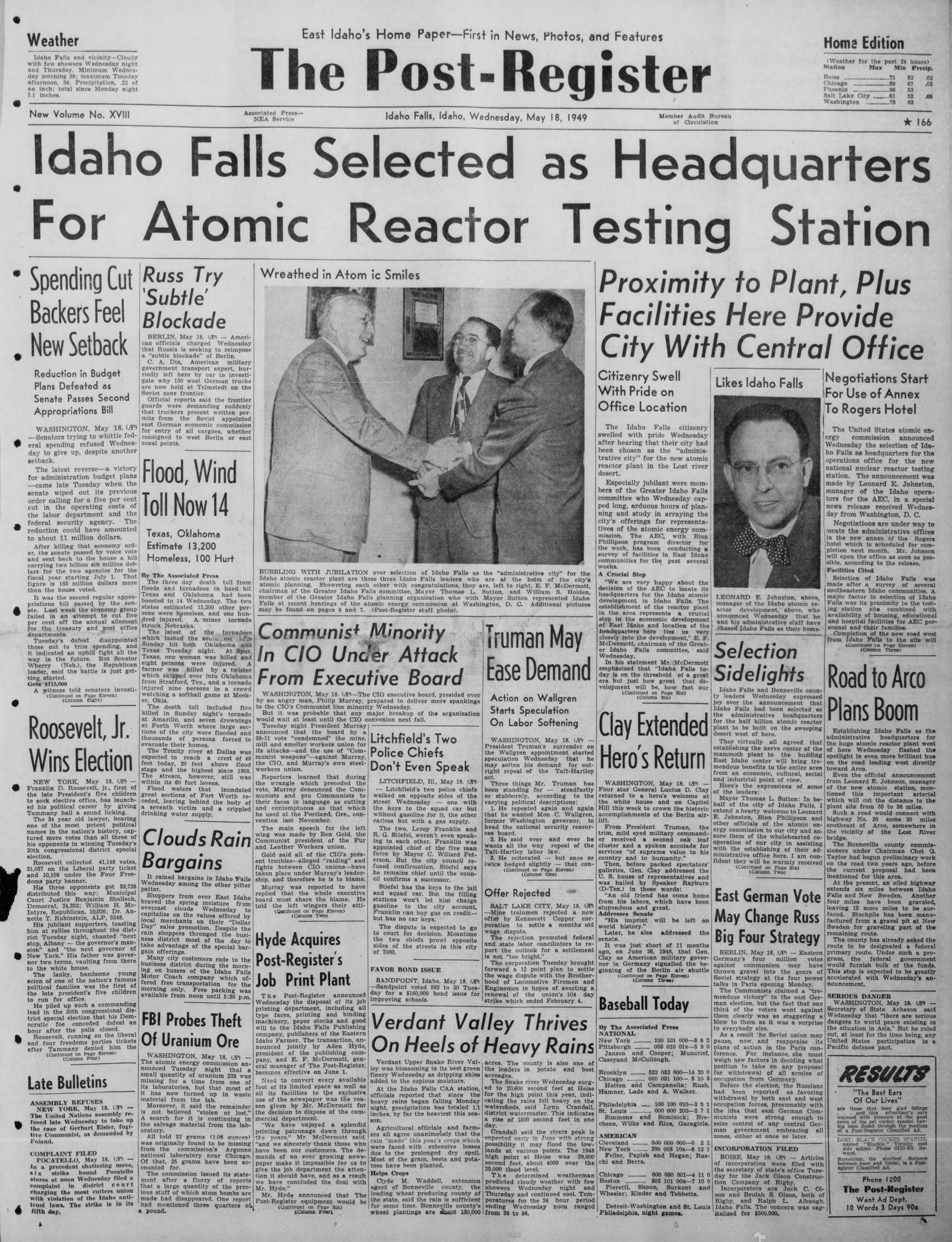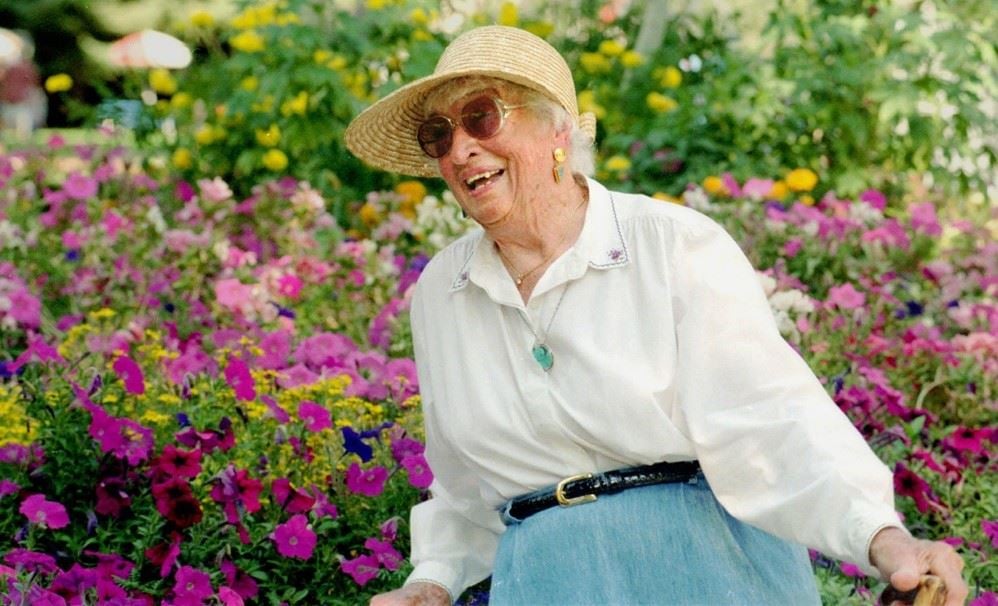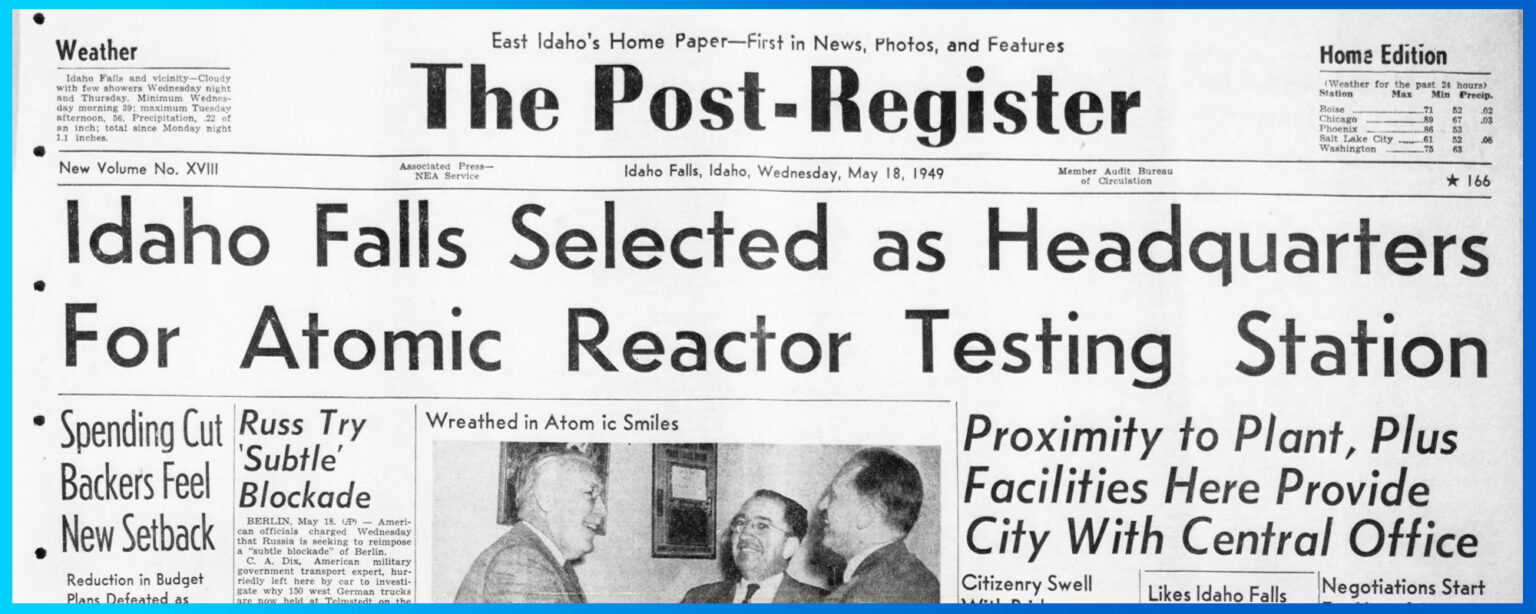In Idaho Falls’ 159-year history, it would be hard to dispute the importance of May 18, 1949. That’s the day the U.S. Atomic Energy Commission (AEC) announced the city as the location for its National Reactor Testing Station headquarters.
In type size normally reserved for events like Pearl Harbor or Kennedy’s assassination, the Post Register’s Page 1 headline read:
Idaho Falls Selected as Headquarters
For Atomic Reactor Testing Station
Until then, Idaho Falls was one of countless small American cities that had begun as a frontier trading post. It had grown to become the county seat and a hub of commerce for eastern Idaho’s scattered agricultural communities. It boasted its own electric utility, ample water from municipally drilled wells, an airstrip and hangar, a ballpark for Pioneer League baseball and an 18-hole golf course and clubhouse.
What first attracted the AEC to eastern Idaho was the presence of the Arco Naval Proving Grounds. During World War II, this was where the U.S. Navy test-fired and sited gunship barrels brought in from the West Coast for reboring in Pocatello before sending them back into service. With the war over, the AEC — established in 1946 and the inheritor of the Manhattan Project — needed a remote location for the reactors it planned to build and test.
Postwar life in Idaho Falls might have progressed sedately, but when city leaders learned that the AEC was planning to build reactors in the sagebrush west of town, it was all hands on deck. When AEC executives visited Idaho Falls, the Chamber of Commerce rolled out the red carpet with receptions, tours and dinners. The “party plan” worked. Idaho Falls got the nod, beating out Pocatello, Blackfoot and Arco.
“I am confident they will be warmly received by the people of Idaho Falls and find this a city in which they will be proud to live in and become an active part of,” Mayor Thomas Sutton said of the newcomers expected to arrive in the next few years.
“I know that our city will measure up to what is expected of us,” said William S. Holden, the attorney who’d first flown with Sutton to Washington, D.C., to pitch Idaho Falls to the AEC. “The influx in our city of the nation’s top scientists and technicians will contribute much to (its) cultural and social advancement.”
Not everyone was thrilled.
“I think Idaho Falls would be a better place to live in if the headquarters and plant were in Montana,” said Snake River Watermaster Lynn Crandall. “It will mean a large influx of population here, with much undesirable element included. The plant itself will probably be the (target) of air attack with atomic bombs if we should get into war. All in all, I think Idaho Falls is a more desirable place to live in now than it will be when the atomic energy plant is built.”

For better or worse, the testing station’s arrival transformed Idaho Falls. Between 1950 and 1960, U.S. Census numbers show the city’s population grew from 19,218 to 33,161. New neighborhoods sprang up on the city’s south and east sides, turning farmland into acres of mid-century homes with driveways, garages and neatly manicured lawns.
Linden Bateman, a longtime high school teacher, state legislator and local historian, recalls hunting frogs in Crow Creek in 1951, when he was 11 years old. “It was right where the new high school was going to be built, and I was just thinking to myself, ‘What are they doing building it so far out of town?” he said. Bateman also enjoyed hunting for arrowheads on the Arco Desert. One day he learned he was no longer allowed on one of his favorite spots. It was the future location of Experimental Breeder Reactor No. 1, and henceforth off limits.
Bonneville County had already begun building a road across the desert to Arco when the AEC announced its intention to set up shop in Idaho Falls. This was not just good news but vindication to County Commission Chairman Chet G. Taylor. “It shows more than ever that we weren’t shooting in the dark when we started work on the road more than two years ago,” he told the Post-Register. “It seems the federal government will now likely help us materially on the road.”
In terms of civic life and culture, the influx of researchers and scientists brought a new level of sophistication to homegrown organizations like the Idaho Falls Music Club. Less than a year after the AEC announcement, a newly formed, 44-member Idaho Falls Symphony gave its first concert in April 1950. By mid-decade the orchestra was seeded with AEC people. These included Deslonde de Boisblanc (cello), best known today for his invention of the Advanced Test Reactor’s serpentine core, and Russell L. Heath (bass viol), whose gamma-ray spectrometry research expanded the nuclear community’s understanding of radioactive materials and is still used extensively today. Both men now have Distinguished Postdoctoral Associate positions at INL named after them.
“Russ was so kind to me,” said Bill Phoenix, who came to play trombone in the symphony in 1966 and soon afterwards joined the testing station as a health physicist. “People like him, they brought culture and attitudes about knowledge, science and music that I’d never known growing up in Pocatello.”
Longtime church congregations found themselves with new members and families. Over its first 58 years, St. John’s Episcopal Church, established in 1895, had been a mission with no full-time clergy. By 1953, it qualified as a full-fledged parish thanks to the arrival of people like George “Kirby” Whitham, a research chemist for Argonne National Laboratory, and his wife Mary Ann. Meanwhile, First Baptist Church, founded in 1875, found itself in need of a bigger building and erected a structure of brick, steel and stained glass across John Adams Parkway from the newly built Civic Auditorium.
The contributions of AEC employees who came in the ‘50s and ‘60s can be seen everywhere, even today. If you’ve ever enjoyed Idaho Falls’ flower beds and baskets in the spring and summer, you can thank Maxine Elliott Kussy, an Iowa-born analytical chemist who came to Idaho Falls from Los Alamos in 1954 to work for Phillips Petroleum. A championship tennis player at the local and state level, Kussy, who died in 1999, donated $50,000 to the city for a greenhouse and to set up the Maxine Elliott Kussy Forget-Me-Not Fund. Now managed by the Idaho Community Foundation, it provides $5,000 annually for the city’s flower-planting program.

“The influx of people with unique talents and families, I think that was a real blessing to the city,” said Joseph Groberg, a lawyer and longtime Idaho Falls City Council member. “We’re all blessed by new ideas and new ways of looking at things.”
Groberg’s father, D.V. Groberg, was a real estate agent who helped lead the Chamber of Commerce’s effort to court the AEC. Born in 1942, Groberg said he was too busy growing up to notice much about how the city was changing in the ‘50s, but he remembers conversations he had with his father.
“Dad always felt the AEC bringing its headquarters here changed the destiny of the town,” he said. “There was much more opportunity for people to get employment outside of agriculture and have steady careers. I would sometimes challenge him about the boom-and-bust nature, but he always felt it was better to have the employment opportunities, even with the ups and downs.”
Would Idaho Falls have ended up a sleepy backwater town if the testing station had never come? “I don’t know what would have happened,” Groberg said. “I suppose that could have happened, but I think Idaho Falls has always had some zip to it that other places out here didn’t have.”








